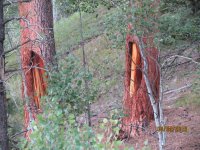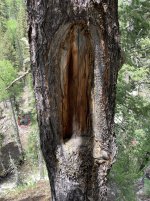cyzak
Bronze Member
- Jul 14, 2018
- 2,421
- 3,987
- Detector(s) used
- My intuition and conscious reasoning, a good tape measure and compass do the math its out there.
- Primary Interest:
- All Treasure Hunting
Follow along with the video below to see how to install our site as a web app on your home screen.
Note: This feature may not be available in some browsers.
Our group has been researching and looking for this treasure since 2004. After spending much time in the San Luis Valley, Pagosa Springs, and South Fork areas, we concluded that the Spanish had to have known French soldiers and miners were in the area from roughly 1748-1756. Also, again 1799-1802. This is because of the relationships that both Spanish and the French had with the local Indians. Furthermore, it would have been impossible to have groups ranging from 200 - 350 men that would have not been discovered. We have read your posts in this forum. You clearly have done much research.
The article you eluded too about the pistol is no surprise. It is a smoking gun. Our research so far places Spanish Conquistadors in the San Luis Valley as early as 1519. Oddly enough, we also had a gentlemen show us a book that possibly puts Montezuma himself in the San Luis Valley as far north as Antonito! How awesome would it be if it some day could be proven!
I think, in the Citadel, Maynard explains the need for the French to leave the Summitville area in the winter. Treasure Mountain is next to Wolf Creek and Summitville is within a day or less hike. There is no way the French would have endured 450" averages of snow at those altitudes. I have hiked TM several times, and know the Wolf Creek Pass area very well. It gets a lot of snow. Taos and Sante Fe would have been the winter destinations of these men. Look forward to your response.
Engelmann Spruce and Ponderosa Pines are the most common. If you want to see an example of such a large old tree, please stop at the Animas Museum in Durango, CO and look at the tree cookie they have on display there. It germinated in 1605, and didn't die until it was cut down near Vallecito Reservoir in the early 2000's.
Here is a blaze I found where I think the treasure is cached. It’s a trail mark that predates 1878, and was commonly used by Europeans and migrated to America. What’s interesting about it is that I found it at the top of a ridge I had to cross to get into a valley where I believe the treasure is.

 I have circled some thing in red to the left of the tree in the back ground you will have to magnify it but this is what to look for to, and I am saying it could be nothing to but research everything.Boots on the ground is the only way this will be found one of these days some one will stumble across it.
I have circled some thing in red to the left of the tree in the back ground you will have to magnify it but this is what to look for to, and I am saying it could be nothing to but research everything.Boots on the ground is the only way this will be found one of these days some one will stumble across it.Here is a blaze I found where I think the treasure is cached. It’s a trail mark that predates 1878, and was commonly used by Europeans and migrated to America. What’s interesting about it is that I found it at the top of a ridge I had to cross to get into a valley where I believe the treasure is.
Do you have any more info to share that you might have discovered.
Did platoro delete his posts in this thread? If not, what page was that quote from where he posted about his group?
It seems almost impossible to stash soo much gold in the amount of time the Frenchman had while fleeing the Indians. Not here throwing cold water on this, just wondering how fast they could have done this with an attack breathing down they're backs?
Does anybody know if there is any information, about this 4 page translation, on page 321 of the book"200 Trails to Gold"?
Did not the Spanish also put the Native Americans on alert to deal with any Frenchman seen poking around in what was then their domain?It was not Indians it was the Spanish who were behind the whole thing I believe the French were assimilated by the Spanish for over fear of death by the Spanish.